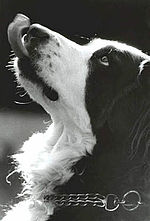Appeasement signal (dog)
Appeasing signals (in English Calming signal or Appeasement signal ) are body language in dogs. It is assumed that these are used during social interactions to communicate with other dogs, but also in interaction with people, to signal friendly mentality, to de-escalate in tense situations and to prevent aggressive behavior. The Norwegian dog trainer Turid Rugaas describes in her book "Calming Signals" anecdotal observations on these soothing behaviors and their use to prevent conflicts. Careful handling of dogs and careful observation and recognition of appeasement signals leads to the early recognition of stress and discomfort in dogs and can thus be the first and most important step in preventing aggressive behavior and incidents of biting.
Stress signals
For some of the behaviors, which are also described as calming signals, there are studies that show a connection between these behaviors and an increased stress level in the dogs.
The signals are not always directed to someone else. It is assumed that these behaviors, in addition to preventing the escalation of a conflict , also serve to reduce stress and tension.
The ability to reduce conflicts with appeasement signals is genetically determined. However, dogs can learn through experience which signals a counterpart reacts to. Are reassurance signals from the human counterpart z. If, for example, they are regularly overlooked or ignored, dogs can learn that it is necessary to communicate their concerns more clearly by, for example, growling or showing their teeth.
Some dogs are also limited in communication by their phenotype. Body type, coat color and coat length can have a strong influence on the communication of dogs. A dog whose eyes are covered by long hair, for example, will not be able to successfully use the reassurance signal “screw up”.
Some examples of reassurance signals are:
- Look away
- Blinking (not staring)
- turn your head away
- turn away (whole body)
- Licking a tongue, licking your nose
- Sniffing on the ground (for no apparent reason), usually looking towards the other person
- go in a curve
- Raise paw
- yawning
- solidify / freeze
- slow movements
- Lower front body (stretch)
- sit down or lie down
All of these signals are not just reassurance signals; after all, dogs yawn when they are tired, lick their noses after eating or scratch themselves when they are itchy. These are so-called double-assigned signals that can have different meanings depending on the situation.
literature
- Turid Rugaas : Calming Signals. The dogs' appeasement signals. Animal Learn Verlag, Bernau 2001, ISBN 3-936188-01-7 .
Individual evidence
- ↑ Angelika Firnkes, Angela Bartels, Emilie Bidoli, Michael Erhard: Appeasement signals used by dogs during dog-human communication . In: Journal of Veterinary Behavior . tape 19 , May 1, 2017, ISSN 1558-7878 , p. 35–44 , doi : 10.1016 / j.jveb.2016.12.012 ( sciencedirect.com [accessed May 4, 2020]).
- ↑ Gazzano, A., Zilocchi, M., Ricci, E., Falaschi, C., Bedini, M., Guardini, G., & Mariti, C .: Calming signals in dogs: from myth to scientific reality? Ed .: Journal of Veterinary Behavior. 2014, doi : 10.1016 / j.jveb.2014.09.008 ( cabdirect.org ).
- ↑ a b c Rugaas: Calming Signals. 2001
- ^ Franziska Kuhne, Johanna C. Hößler, Rainer Struwe: Effectsofhuman-dogfamiliarityondogs'behaviouralresponsestopetting . Ed .: Applied Animal Behavior Science. 2012.
- ↑ a b Beerda, B., Schilder, MB, Van Hooff, JA, De Vries, HW, & Mol, J. A: Chronic stress in dogs subjected to social and spatial restriction. Ed .: Physiology & behavior ,. No. 66 (2), 233-242 , 1999.
- ↑ Beerda, B., Schilder, MB, van Hooff, JA, de Vries, HW, & Mol, JA: Behavioral, saliva cortisol and heart rate responses to different types of stimuli in dogs. Ed .: Applied Animal Behavior Science. 1997.
- ↑ Beerda, B., Schilder, MBH, van Hoof, JARAM, de Vries, HW, Mol, JA: Behavioral, saliva cortisol and heart rate responses to different types of stimuli in dogs . Ed .: Applied Animal Behavior Science. 1998.
- ↑ Schilder, MB, & van der Borg, JA: Training dogs with help of the shock collar: short and long term behavioral effects. Ed .: Applied Animal Behavior Science. 2004.

